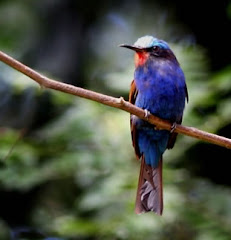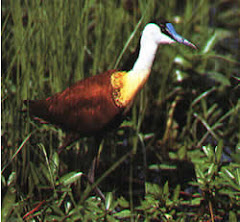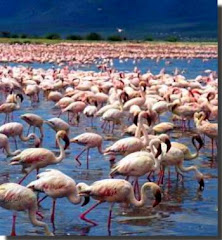
The Kenya birding safari starts in Nairobi National Park followed by the Rift Valley Lakes which is a mixture of fresh water lakes (Naivasha and Baringo) and salt water lakes (Nakuru and Bogoria). Further west we find the unique Kakamega Forest, a remaining patch of the tropical rain forest . We end the tour birding in Masai Mara, the Africa of everyone's dream: rolling plains, great wildlife and a wide diversity of birds species.
DAY 1: NAIROBI NATIONAL PARK
After breakfast we drive to the Nairobi National Park, which despite being only a few kilometers from the city, is a home to big game. In its open grasslands scattered with acacia trees we will see the first game like Gazelles, Zebras, Giraffes and maybe some of the Cats.
On our birding venture we will see Ostrich, Secretary Bird, Crowned Crane, Vulture, Cattle Egret, Great Egret, Tawny Eagle and a herd of Buffaloes should provide Red-billed Oxpecker perched on their backs. Black Kite, Marabou Stork, Pied Crow and African Palm Swift are also available in the park.
A walk around the Hippo pools should give us our first sighting of the Nile Crocodiles and the Helmeted Guineafowl. In the Yellow-backed Acacia, look out for Grey Crowned Crane, Red-throated Tit and Chestnut-banded Plover.
Overnight at a hotel in Nairobi.
After breakfast we drive to the Nairobi National Park, which despite being only a few kilometers from the city, is a home to big game. In its open grasslands scattered with acacia trees we will see the first game like Gazelles, Zebras, Giraffes and maybe some of the Cats.
On our birding venture we will see Ostrich, Secretary Bird, Crowned Crane, Vulture, Cattle Egret, Great Egret, Tawny Eagle and a herd of Buffaloes should provide Red-billed Oxpecker perched on their backs. Black Kite, Marabou Stork, Pied Crow and African Palm Swift are also available in the park.
A walk around the Hippo pools should give us our first sighting of the Nile Crocodiles and the Helmeted Guineafowl. In the Yellow-backed Acacia, look out for Grey Crowned Crane, Red-throated Tit and Chestnut-banded Plover.
Overnight at a hotel in Nairobi.
DAY 2&3: MENENGAI CRATER And LAKE NAKURU
After breakfast we leave Nairobi via the Nakuru road to the Rift valley. The Nairobi - Nakuru road is on a contour along the rim of the Rift valley and on viewpoints we will be able to see our whole route for the next days.
On the way we take a brief birding stop at the Limuru Swamp to see resident birds species such as Little Grebe, Yellow-billed and Maccoa Duck, Pelicans, Coots, Egrets and Herons. Soaring are Black Kite, Augur Buzzard and Pied Crow.
The Menengai area is very beautiful with cliff walls and steam jets filling the crater with mist. It is only 10 km from the Nakuru National Park and has not been touched by tourism. This is an easy to explain situation as safari evolves around wildlife with other geographical features being relegated to viewpoints that is if they happen to be visible from a highway. Fortunately Menengai Crater is off the highway, so it is spared the viewpoint ritual of convoys of tour buses stopping for the mandatory 10 minutes break of photo taking.
In the afternoon of day 3 we will do a birding walk in the crater where we will enjoy the beautiful contrasts of nature. Rocks that have stood the test of time, natural springs with mirror clear water, lava that reminds us that this is the Rift Valley and baboons trooping around with their babies. Possible sightings here are the Common Stonechat, Yellow-rumped Seedeater, Cinnamon-breasted Rock Bunting, Yellow Bishop, Yellow-mantled Widowbird, Northern Anteater chat, White-fronted Bee-eater and Shallow's Wheatear.
On day 4 Lake Nakuru
On the way we take a brief birding stop at the Limuru Swamp to see resident birds species such as Little Grebe, Yellow-billed and Maccoa Duck, Pelicans, Coots, Egrets and Herons. Soaring are Black Kite, Augur Buzzard and Pied Crow.
The Menengai area is very beautiful with cliff walls and steam jets filling the crater with mist. It is only 10 km from the Nakuru National Park and has not been touched by tourism. This is an easy to explain situation as safari evolves around wildlife with other geographical features being relegated to viewpoints that is if they happen to be visible from a highway. Fortunately Menengai Crater is off the highway, so it is spared the viewpoint ritual of convoys of tour buses stopping for the mandatory 10 minutes break of photo taking.
In the afternoon of day 3 we will do a birding walk in the crater where we will enjoy the beautiful contrasts of nature. Rocks that have stood the test of time, natural springs with mirror clear water, lava that reminds us that this is the Rift Valley and baboons trooping around with their babies. Possible sightings here are the Common Stonechat, Yellow-rumped Seedeater, Cinnamon-breasted Rock Bunting, Yellow Bishop, Yellow-mantled Widowbird, Northern Anteater chat, White-fronted Bee-eater and Shallow's Wheatear.
On day 4 Lake Nakuru
We go bird watching in Lake Nakuru, which is famous for its thousands of Lesser Flamingos - the Greater Flamingoes will be easily distinguishable by their height. The Great White and Pink-backed Pelican and Black-winged Stilt are also there.
The lake has a low concentration of salt, so it supports fish that of course attract other water birds.
It is a good place to look for Avocets, Storks, Ibises, Ducks, Cormorants, Herons, and Terns. In the wooded acacias there is a chance to see the White-browed Coucal, Broad-billed Roller, Arrow-marked Babbler and the Narina Trogon.
We go with a picnic lunch, so that we can take a full day for birding and game viewing in the park.
The lake has a low concentration of salt, so it supports fish that of course attract other water birds.
It is a good place to look for Avocets, Storks, Ibises, Ducks, Cormorants, Herons, and Terns. In the wooded acacias there is a chance to see the White-browed Coucal, Broad-billed Roller, Arrow-marked Babbler and the Narina Trogon.
We go with a picnic lunch, so that we can take a full day for birding and game viewing in the park.
DAY 5, 6 & 7: LAKE BARINGO
After breakfast we head further north to Lake Baringo which without doubt is a one of the most interesting places for bird watching in Kenya because of the different habitats that are found with-in a small radius. There is the fresh water lake with a slight degree of alkalinity, cliffs, open grasslands as well as scattered bushes.
Over 400 species of birds have been recorded. The woodlands by the lake are alive with White-browed Sparrow-Weavers, Jackson's and Red-billed Hornbills, Bristle-crowned Starlings, and the rare Northern Masked Weavers, there are several Hamerkops along the lakeshore and with luck we should be able to see their nest, which a pair of Grey Kestrels have adopted as a home. There will be time to relax, enjoy the pool, and bird the grounds of the lodge for the resident Spotted Eagle-owls, and Sunbirds such as the Beautiful, Hunter's and the Violet-breasted. Nightjars are common on the lakeshores at night and the Hippos graze freely on the lodge's lawn. Overnight is at lodge.
After breakfast we head further north to Lake Baringo which without doubt is a one of the most interesting places for bird watching in Kenya because of the different habitats that are found with-in a small radius. There is the fresh water lake with a slight degree of alkalinity, cliffs, open grasslands as well as scattered bushes.
Over 400 species of birds have been recorded. The woodlands by the lake are alive with White-browed Sparrow-Weavers, Jackson's and Red-billed Hornbills, Bristle-crowned Starlings, and the rare Northern Masked Weavers, there are several Hamerkops along the lakeshore and with luck we should be able to see their nest, which a pair of Grey Kestrels have adopted as a home. There will be time to relax, enjoy the pool, and bird the grounds of the lodge for the resident Spotted Eagle-owls, and Sunbirds such as the Beautiful, Hunter's and the Violet-breasted. Nightjars are common on the lakeshores at night and the Hippos graze freely on the lodge's lawn. Overnight is at lodge.
On day 6 Lake Bogoria
we go birding to the nearby alkaline lake of Bogoria, famous for its thousands of flamingos and beautiful hot springs. As this area is very hot, we go early and return to the Baringo Country Club in time for a late lunch. Afternoon is spent birding leasurely in the garden of the lodge.
Before breakfast on day 7 we will bird the escarpment and surrounding countryside for Hemprich's and Eastern Yellow-billed Hornbill, White-crested Turaco, Madagascar Bee-eater, Rufous-crowned Roller, Gabar Goshawk, Cliff Chat and Verreaux's Eagle which feeds on the Rock Hyrax.
Later on the day we make a boat ride over Lake Baringo, always on the lookout for new bird species. We will come close to the Goliath Heron, African Fish Eagle, Malachite Kingfisher, plus swimming hippo and crocodiles.
Before breakfast on day 7 we will bird the escarpment and surrounding countryside for Hemprich's and Eastern Yellow-billed Hornbill, White-crested Turaco, Madagascar Bee-eater, Rufous-crowned Roller, Gabar Goshawk, Cliff Chat and Verreaux's Eagle which feeds on the Rock Hyrax.
Later on the day we make a boat ride over Lake Baringo, always on the lookout for new bird species. We will come close to the Goliath Heron, African Fish Eagle, Malachite Kingfisher, plus swimming hippo and crocodiles.
DAY 8 & 9: KAKAMEGA FOREST
Kakamega forest, in the heart of an intensively cultivated agricultural area, is a superb remainder of virgin tropical rainforest and is of course the home to a wide range of specialty birds, many which are not found anywhere else in Kenya. The forest is not only home to the rare De Brazza's monkey (only found in Kakamega Forest), but also to the Hammer-headed Fruit Bat, Flying Squirrel, 400 species of butterflies and no less than 330 species of birds.
Yes, birding in a forest has its fair share of difficulties but this is easily forgotten when our count increases with hopeful sightings of the impressive Black-and-white-casqued Hornbill, Ross' and the Great Blue Turaco. Other notables are the Grey-headed Negro-finch, Red-headed Bluebill, Chestnut Wattle-eye, Mackinnon’s Shrike and many more.
DAY 10: LAKE NAIVASHA
A scenic transfer through the Nandi Hills and the tea rich area of Kericho takes us back to Nakuru and further south to the Lake Naivasha area.
Lake Naivasha is a fresh water lake without a known outlet. This is very strange considering that the rivers that feed it are salty. The lake has dense vegetation, which in turn supports a variety of birds. The area has a bird count of 350 species.
We reach Lake Naivasha in time for a late lunch where we'll stay for the next two nights. In the afternoon we do a bird walk in the garden of the hotel, which borders the lake. A late afternoon boat ride gives us not only the chance to see numerous Hippos but also a wide variety of fresh water birds. A nocturnal visitor in this lodge is the hippo, whose deep munching we will easily identify from the comfort of our rooms.
Kakamega forest, in the heart of an intensively cultivated agricultural area, is a superb remainder of virgin tropical rainforest and is of course the home to a wide range of specialty birds, many which are not found anywhere else in Kenya. The forest is not only home to the rare De Brazza's monkey (only found in Kakamega Forest), but also to the Hammer-headed Fruit Bat, Flying Squirrel, 400 species of butterflies and no less than 330 species of birds.
Yes, birding in a forest has its fair share of difficulties but this is easily forgotten when our count increases with hopeful sightings of the impressive Black-and-white-casqued Hornbill, Ross' and the Great Blue Turaco. Other notables are the Grey-headed Negro-finch, Red-headed Bluebill, Chestnut Wattle-eye, Mackinnon’s Shrike and many more.
DAY 10: LAKE NAIVASHA
A scenic transfer through the Nandi Hills and the tea rich area of Kericho takes us back to Nakuru and further south to the Lake Naivasha area.
Lake Naivasha is a fresh water lake without a known outlet. This is very strange considering that the rivers that feed it are salty. The lake has dense vegetation, which in turn supports a variety of birds. The area has a bird count of 350 species.
We reach Lake Naivasha in time for a late lunch where we'll stay for the next two nights. In the afternoon we do a bird walk in the garden of the hotel, which borders the lake. A late afternoon boat ride gives us not only the chance to see numerous Hippos but also a wide variety of fresh water birds. A nocturnal visitor in this lodge is the hippo, whose deep munching we will easily identify from the comfort of our rooms.
DAY 11: HELL'S GATE NATIONAL PARK
Hell's Gate is only a short drive away from the lodge. The first part is open grasslands bordered with steep rock cliffs in which the Rüppell's Griffon Vulture nests. Easy sightings here are the Verreaux's or Black Eagle, Common Ostrich, Black-shouldered Kite, White-fronted Bee-eater, Grassland and Long-billed Pipit, Northern and Schalow's Wheatear, Lilac-breasted Roller...
The narrow gorge has a completely different habitat and hence very different birds: Yellow, Grey and African Pied Wagtail, Red-cheeked Cordonbleu, Purple Grenadier, Common Drongo, Superb Starling, Brimstone Canary, Common Waxbill, White-browed Robin-Chat...
Hell's Gate is only a short drive away from the lodge. The first part is open grasslands bordered with steep rock cliffs in which the Rüppell's Griffon Vulture nests. Easy sightings here are the Verreaux's or Black Eagle, Common Ostrich, Black-shouldered Kite, White-fronted Bee-eater, Grassland and Long-billed Pipit, Northern and Schalow's Wheatear, Lilac-breasted Roller...
The narrow gorge has a completely different habitat and hence very different birds: Yellow, Grey and African Pied Wagtail, Red-cheeked Cordonbleu, Purple Grenadier, Common Drongo, Superb Starling, Brimstone Canary, Common Waxbill, White-browed Robin-Chat...
DAY 12, 13 & 14: MASAI MARA
We head to the famous Masai Mara National Reserve, which borders Serengeti in Tanzania. Mara is the gem of birding and game viewing in Kenya with 450 species recorded. We will drive through Masai land, home to one of the most fascinating cultures in Africa.
In the vast grasslands we expect to see Elephants; the large Cats - Lion, Leopard, and Cheetah; the herd animals - Zebra, Wildebeest, Thompson's and Grant's Gazelles; and specialties like the Hartebeest and the Topi.
Expected bird species are the highly conspicuous Common Ostrich, the small but still conspicuous Cardinal Quelea, Sooty Chat, Ground Hornbill, Open-billed Stork, Temminck's Courser, Yellow-throated Sandgrouse and Denham's Bustard. Lilac-breasted Rollers are common. If we find a kill, we may see six species of vultures all dining together: Egyptian, Hooded, Griffon, Lappet-faced, White-backed and White-headed.
We head to the famous Masai Mara National Reserve, which borders Serengeti in Tanzania. Mara is the gem of birding and game viewing in Kenya with 450 species recorded. We will drive through Masai land, home to one of the most fascinating cultures in Africa.
In the vast grasslands we expect to see Elephants; the large Cats - Lion, Leopard, and Cheetah; the herd animals - Zebra, Wildebeest, Thompson's and Grant's Gazelles; and specialties like the Hartebeest and the Topi.
Expected bird species are the highly conspicuous Common Ostrich, the small but still conspicuous Cardinal Quelea, Sooty Chat, Ground Hornbill, Open-billed Stork, Temminck's Courser, Yellow-throated Sandgrouse and Denham's Bustard. Lilac-breasted Rollers are common. If we find a kill, we may see six species of vultures all dining together: Egyptian, Hooded, Griffon, Lappet-faced, White-backed and White-headed.
In addition we will encounter numerous raptors such as Bateleur, Martial and Tawny Eagles, as well as Pale Chanting Goshawk, Augur Buzzards and Black-chested Snake Eagles. Along the Mara River we'll watch for African Finfoot, Schalow's and Ross' Turaco, Crested Guineafowl, Woodland Kingfisher, Yellow-billed Barbet, Black-billed Weaver, Violet-backed Starling, and perhaps with luck, Pel's Fishing Owl. Any tapping noise on the trees may be indicative of the relatively uncommon Woodpeckers (Golden-tailed and Fine-banded). Hopefully we will be lucky enough to see some of the more difficult to see mammals such as Bat-eared Fox, Hunting Dog, Serval and the delightful Banded Mongoose.
DAY 15: Maasai Mara – Nairobi
Heading north to Narok, we stop to browse in the bustling, vibrant Maasai markets to buy curios and handicrafts before continuing to Nairobi where our safari ends.


















